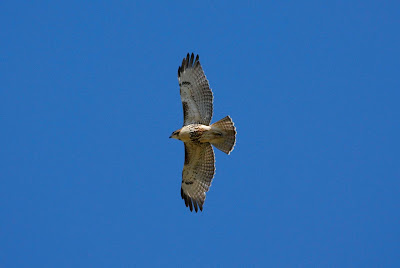
Photo credit: Joe Medley (I adjusted the exposure to make it brighter. Any loss in quality is my fault, not Joe's!)
Click on photo above to view larger size
So, I didn't fool anyone with this quiz (at least anyone who responded)! My good friend, Joe Medley, took this photo of an adult dark morph Ferruginous Hawk near Merced, California in January 2009.
The diagnostic features that I noticed on this bird were the large gape extending below the eyes and the rufous wash on the upperwing coverts, nape and chest of this bird. A couple of you mentioned the feathered legs (tarsi). I would be cautious using that as an identification point when a bird is perched like this. It is hard to separate the leg feathers from the belly feathers. One of you thought the bird was a juvenile. Juvenile Ferruginous Hawks don't have the extensive rufous coloring that this adult shows.
Here are the respondents who answered correctly:
Will Burt
Karen Carlsen
Lucas Foerster
Jen McCabe
Joel Such
Marcel Such
And the final top five scores from the 2009 photo quiz are (drumroll please)*:
Joel Such 8
Marcel Such 8
Karen Carlsen 7
Deirdre Viel 6
Jessica Lux 5
*out of 8 possible.
Thanks for participating. I will start a new photo quiz in the next couple weeks. I think they will be a little more difficult in the next round.
Now, get off your computers and go birding!
Jeff
RMBO Photo Quizmaster






